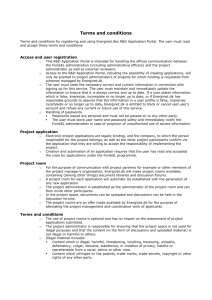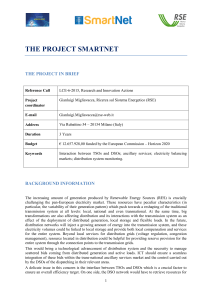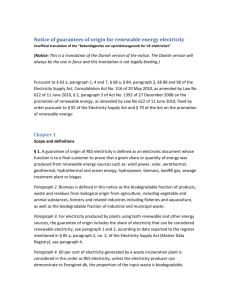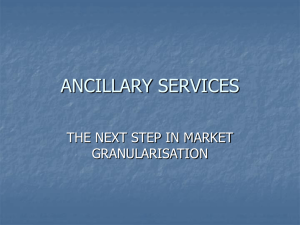Energinet.dk's ancillary services strategy 2015-2017
advertisement
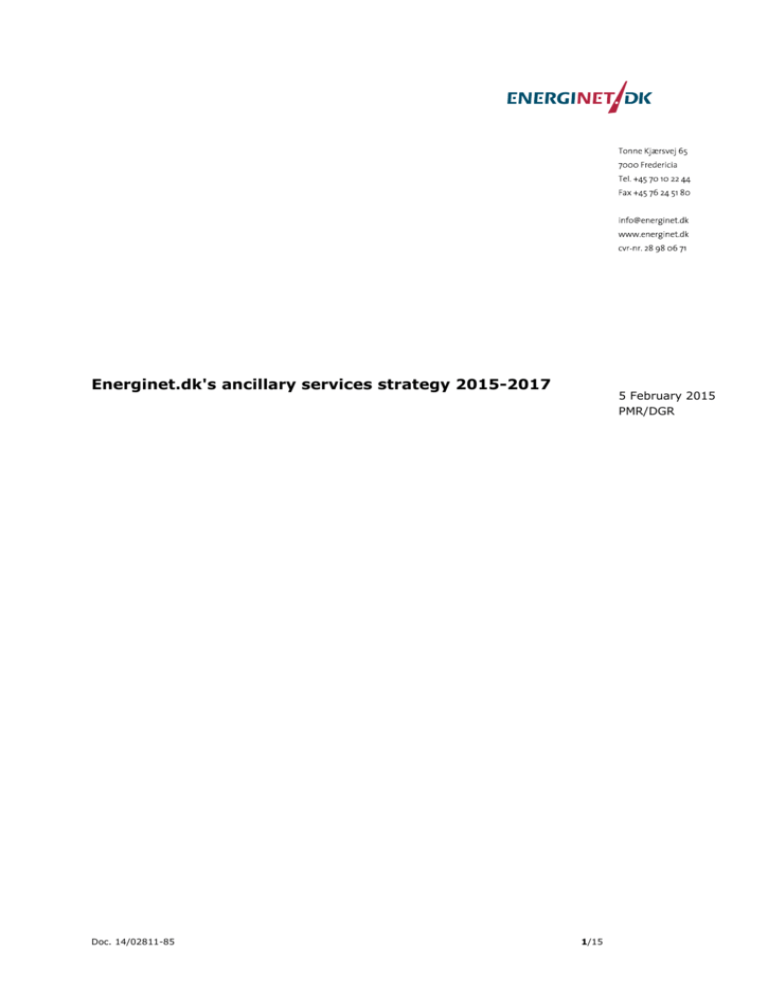
Energinet.dk's ancillary services strategy 2015-2017 Doc. 14/02811-85 5 February 2015 PMR/DGR 1/15 1. Introduction In August 2014, Energinet.dk published its group strategy plan for 2015-2017 entitled 'Integration'. This ancillary services strategy should be seen in light of Energinet.dk's group strategy plan and explains how the ancillary services area can contribute to meeting the three commitments set out in the strategy plan: - We guarantee a high level of security of supply for electricity and gas – now and in the future We take responsibility for an economically viable transition We contribute to a healthy investment climate in the energy sector. We have chosen to focus on ancillary services in a separate strategy because ancillary services play a significant role in the development and operation of the power system and thus in ensuring Energinet.dk's ability to meet its commitments. The strategy was prepared in autumn 2014, with the involvement of market players and other stakeholders. In addition to the strategy, a memo has been published which describes this process and provides further background and framework for the strategy, thus putting the strategy into perspective1. The new strategy is based on the basic framework defined in the ancillary services strategy 2011-2015 and considers the overall efforts towards 2020 as well as specific initiatives in 2015-2017 in line with the group strategy plan. 2. Energinet.dk's ancillary services principles From an overall point of view, Energinet.dk's objective is to ensure wellfunctioning markets and procurement of ancillary services, thereby facilitating sales for Danish players and ensuring access to the necessary resources. The energy system is currently undergoing significant changes; a trend which will continue in future. Fluctuating renewable energy from wind turbines and solar cells is being introduced into the power system to an ever-increasing extent. This places considerable demands on Energinet.dk's handling of the power system, including in particular the balancing of the system, where ancillary services constitute an important element. The phasing out of power stations as a consequence of the fact that an everincreasing portion of the electricity consumption is being covered by wind and solar energy poses a special challenge. The power stations have traditionally been, and still are, important suppliers of ancillary services. Energinet.dk therefore focuses on ensuring that the necessary functionality can be procured in an economically optimum manner, despite the declining number of power stations, eg from wind turbines, the demand side, international connections and grid components. 1 Available in Danish only Doc. 14/02811-85 2/15 With a view to addressing these challenges, we centre the strategy on three principles: - - - Internationalisation, which offers the opportunity to procure ancillary services abroad while strengthening Danish suppliers through improved sales opportunities. Competition, including providing better opportunities for new technologies and suppliers to participate in the markets and ensuring that all major supplies to the power system are priced correctly. Transparency, including providing better insight for the market players into Energinet.dk's internal processes and making more information about the markets available. High level of security of supply Efficient transition Healthy investment climate Transparency Competition Internationalisation Ancillary services strategy Figure 1 Three principles underpinning Energinet.dk's commitments. The three principles map the direction of the future work with ancillary services. At the same time, we define specific initiatives in the strategy which underpin the principles, but we also emphasise that it may be necessary and expedient to reconsider these over the course of the strategy period, as new opportunities arise or framework conditions change. The principles above will then form the framework for new and/or adapted objectives. We believe that all three principles are equally important, and the order in which they are mentioned should therefore not be seen as a reflection of any prioritisation of the principles relative to each other. In the following sections, the specific initiatives within each principle are described. Each initiative is stated in a text box and is consecutively numbered. In conclusion, an overview is provided of the timing of the initiatives. 3. Internationalisation 3.1 Long-term objective Energinet.dk believes that international markets for ancillary services are a viable way of ensuring a high security of supply at the lowest possible economic Doc. 14/02811-85 3/15 costs. This results in more liquid markets with good competition and robustness to changing needs and technological possibilities. This is also in line with the EU's overall ambitions to develop a coherent European energy market. Energinet.dk continuously assesses the opportunities for exchanging and sharing reserve capacity across borders and assesses on the whole how reserve capacity should be dimensioned and procured in an ever more closely connected European power system with very large concentrations of wind and solar energy at local level. As concerns the establishment of joint reserve capacity markets, the coming network codes2 set out the direction. The network codes will enter into force during the strategy period 2015-2017, with a subsequent implementation period. We therefore believe that the efforts should focus on a gradual implementation of the network codes through pilot projects and bilateral/regional cooperation. The issue of transmission capacity reservation is a key element in the long-term vision of coherent reserve capacity markets. The network codes mention various methods of handling reservations in a market perspective, among other things the possibility that players can make the reservations. Energinet.dk sees it as a positive aspect that the possibility of reservation is available and will, based on economic assessments, consider this possibility, where relevant. As there is no immediate short-term possibility of making reservations on the existing connections, Energinet.dk has no plans of making any further transmission capacity reservations during the strategy period in addition to the reservations already made. 3.2 Energinet.dk's efforts in the short term Energinet.dk is involved in various international cooperation projects with a view to establishing and maintaining alliances that are a condition for concluding agreements and establishing international trading in ancillary services. Energinet.dk will maintain and strengthen these efforts going forward. 1 Energinet.dk will continue to pursue structured efforts to strengthen alliances with the most important TSOs with a view to establishing common markets for ancillary services. Examples of this could be: - The close cooperation with the Nordic TSOs Bilateral semi-annual workshops with the neighbouring TSO TenneT in Germany IGCC.3 As concerns FCR4, Energinet.dk's objective is to establish trading across price and synchronous areas. This does not require reservation of transmission capac2 Rules for a common European power market. See http://networkcodes.entsoe.eu/. 3 IGCC = International Grid Control Cooperation; cooperation on the netting of imbalances with the potential for expansion into further trading. In addition to Denmark, Germany, Austria, Switzerland, the Netherlands, Belgium and the Czech Republic participate in the cooperation. 4 FCR = Frequency containment reserve; fast reserve capacity that stabilises the frequency in the event of outages in the power system. Doc. 14/02811-85 4/15 ity, as such reserve capacity is normally only activated for short periods of time and therefore involves the supply of insignificant energy volumes. For AC connections, the exchange may take place within the existing margins on the connection. This has already been established in Eastern Denmark which, via Oresund, is part of a joint Swedish/Danish market. There are no plans to introduce changes in this market, but an ongoing analysis of the Nordic frequency quality might result in adapted product definitions, including in particular response time requirements. As concerns Western Denmark, a similar solution is expected to be established on the Jutland-German interconnection (initiative 2). For DC connections, Energinet.dk will investigate the possibilities of exploiting an additional short-term load capacity, if any, for the exchange of reserve capacity (initiative 3). In 2015, the supply of primary reserve capacity from Norway via the interconnection between Jutland and Norway (Skagerrak) functions as the basis for experience gathering and for assessing whether establishing similar solutions on other interconnections would be possible and expedient. 2 Energinet.dk will establish the possibility of Danish participation in the common market for FCR with Germany, the Netherlands, Switzerland and Austria. At the beginning of 2015, a test project will be carried out using a new model for calculating TRM5 on the Jutland-Germany interconnection, which will be used to transfer the reserve capacity. The further process depends on the outcome of this test project. Energinet.dk's objective is Danish participation in the common market by 1 January 2016 at the latest. This requires that the TRM test project is successful, and that the German regulator, the Federal Network Agency for Electricity, Gas, Telecommunications, Post and Railway (Bundesnetzagentur), is subsequently willing to approve the interconnection between Jutland and Germany for trading in FCR. 3 Energinet.dk will investigate the economic benefits of and technical opportunities for establishing trading in frequency-controlled reserves via DC connections without reserving transmission capacity on the connections, eg supply of FDR from Western to Eastern Denmark. The initiative will be launched at the beginning of 2016 based on experience from the exchange of reserve capacity across the Skagerrak interconnection and is expected to be completed in October 2016. One or more implementation projects may follow after this, depending on the outcome of the analysis. As concerns FRR6, Energinet.dk will implement more initiatives aimed at the international markets. In the Nordic countries, concerted efforts are being de5 TRM = Transmission reliability margin; a safety margin incorporated in the assessment of available capacity to cover current minor imbalances caused by, for example, short-term forecasting errors. Doc. 14/02811-85 5/15 voted to establishing a common market for both FRR-A capacity and activation (initiative 4). Towards the Continent (Germany), Energinet.dk is initially working to open up for cross-border trading in FRR-A and FRR-M activation (initiative 5 and initiative 6, respectively). Such activation takes place at the time of operation and can be made across borders in the cases where unused transmission capacity is available in the desired direction. Trading in FRR activation thus does not require advance reservation of transmission capacity, as the activation can be carried out nationally if the connection is already being fully utilised by other trading. This has the immediate effect that competition is achieved on the activation price and potentially larger markets are obtained for the suppliers. In addition, it has the effect going forward that it will contribute to interconnecting the markets internationally, despite the fact that reserve capacity cannot immediately be traded. The way is thus being paved for a future linking of the markets, also in terms of capacity. The challenge in establishing cross-border trading in FRR to Germany is that the German market model for these products excludes players that have not obtained availability payment from bidding on the activation. In order for Danish players to be able to bid on the activation, the German market design must thus be adapted with a view to opening up for 'voluntary bids'. The schedules for these activities are subject to uncertainty, but may be driven by the implementation of the network codes, which propose requirements for the use of free bids. 4 Energinet.dk will contribute to establishing a common Nordic FRR-A market. A joint Nordic solution for FRR-A capacity is expected to be established in 2016, but it is uncertain, however, how transmission capacity limitations should be handled in this market, and thus uncertain how large volumes Danish players will be able to offer in the market. A pilot project concerning reservation of FRR-A capacity is currently being conducted on the Hasle interconnector between Norway and Sweden. Trading in activation is expected to be established in 2017, which will enable activation utilising unused transmission capacity. 6 FRR = Frequency restoration reserve; reserve capacity that is to eliminate imbalances within a maximum of 15 minutes. Divided into automatic (FRR-A) and manual (FRR-M) reserve capacity. Doc. 14/02811-85 6/15 5 Energinet.dk will establish cross-border trading in FRR-A activation in relation to Germany. Under the auspices of IGCC, specifically, there is a potential for 'SCR assistance'7 and cross-border FRR-A activation, possibly with a common bidding list. These options will be analysed in 2015, and the further plans depend on the outcome of these analyses. Until a significant demand for FRR-A has been secured which ensures that Danish players have an incentive to maintain the ability to supply FRR-A, Energinet.dk will ensure maintenance of our supply ability through calls for tenders for FRR-A supply ability. 6 Energinet.dk will establish trading in regulating power (activation of manual reserve capacity, FRR-M) between the Nordic and the continental synchronous area. A pilot project under the auspices of ENTSO-E is currently analysing the possibilities. In the event of a positive outcome of the pilot project, a specific market solution will be designed, IT systems will be implemented and a test period will be commenced. The solution is expected to be ready for market operation in mid-2018. 3.3 Consequences for Danish players To support international market integration, Energinet.dk cooperates with other TSOs on harmonising products and marketplaces. This may lead to Danish characteristics in the market design being abandoned, eg low limits for minimum bid size and markets with high time resolution and short time frames. Energinet.dk acknowledges that, in the short term, this may be to the disadvantage of some of the Danish market players. We believe, however, that the participation in international markets outweighs this disadvantage and that, in the long term, the potential for exerting an influence on the international market is improved by participating in the market as soon as possible rather than by remaining outside. This is also true in relation to product definitions and technical requirements, which Energinet.dk is working continuously to harmonise in cooperation with other TSOs. Energinet.dk believes that this is a prerequisite for establishing common markets and for establishing equivalent – though not necessarily identical – product definitions. In practice, this means that there may be slight differences between the technical requirements in different countries, which allows for the establishment of competition across borders without disproportionately high conversion costs for the players involved. 4. Competition It is a condition for well-functioning markets that sound competition can be established in the markets. In the coming strategy period, Energinet.dk will there7 Possibility for a TSO to automatically activate FRR-A regulating energy from another TSO in strained situations. Doc. 14/02811-85 7/15 fore implement initiatives aimed at strengthening competition in the ancillary services markets. The efforts are focused partly on valuation of the technical services and properties required to operate the power system and partly on opening the markets to new suppliers by removing barriers. 4.1 Valuation of technical services and properties Energinet.dk will explore the possibilities of creating new ways of valuing technical services and properties in respect of which there is currently no or limited competition. This applies specifically to properties required to maintain power system stability, in which context Energinet.dk has purchased synchronous condensers that partially cover the need for properties required to maintain power system stability. Energinet.dk has chosen this strategy for the purpose of reducing the economic costs of securing the properties required to maintain power system stability. Going forward, the strategy in this area consists of two aspects: Investment and operations: - - In terms of investment, Energinet.dk still finds it appropriate to invest in grid components as an integral part of the transmission grid, if the economic costs of ensuring the necessary properties in the system can be reduced. In terms of operations, Energinet.dk may in certain operating situations choose between using own grid components or purchasing similar properties as a service from a power station. Energinet.dk will therefore examine the possibilities of establishing solutions for optimising the operating expenses across own grid components and commercial suppliers. In this context, Energinet.dk will also establish mechanisms to ensure that the need for properties required to maintain power system stability in all normal operating situations is covered by own grid components and/or by an equivalent service purchased on market terms. Alternatively, Energinet.dk could order plants to be started up in order to supply the service; this is a tool that Energinet.dk believes should be used in rare cases only. Doc. 14/02811-85 8/15 7 Energinet.dk will analyse the possibilities of more market-based purchasing of properties required to maintain power system stability. The analysis will cover two main areas: - - Possibility of optimising operating expenses across commercial suppliers of properties required to maintain power system stability and Energinet.dk's own grid components. Reduction of forced operation (orders) by prioritising marketbased purchasing and/or the use of Energinet.dk's grid components. The initiative will be launched in mid-2016 and is expected to be completed by the end of 2016. Subsequently, a process of adapting specifications and technical regulations may follow, depending on the outcome of the analysis. Initiative 10 forms the foundation for this initiative and must be completed first. In addition to the properties required to maintain power system stability, there are certain technical properties and functions which are required today as part of the technical regulations, but which may be in the nature of ancillary services. Energinet.dk will therefore examine to which extent it is possible to determine the value of these and define them as products/services that can be purchased on an equal footing with other ancillary services. 8 Energinet.dk will analyse the possibilities for a new valuation of services and properties that create value for the power system, and that are not currently regarded as ancillary services. In this connection, Energinet.dk will prepare an overview of Energinet.dk's need for technical properties and other functionality that ensure the safe operation of the power system, including how this need is covered through ancillary services and requirements in technical regulations. The overview will serve as the starting point for a discussion with stakeholders. The analysis will be based on the findings and recommendations from Market Model 2.0 and conducted in the second half of 2015, with subsequent implementation of any new services in the course of 2016, including method approval from the Danish Energy Regulatory Authority. 4.2 Focus on removing barriers Energinet.dk believes that the markets for ancillary services should to the widest possible extent allow all suppliers to participate, regardless of the technology behind the production of a given service. It is important that there are no barriers which, in practice, keep some suppliers out of the market. This could, for example, be flexible electricity consumption or wind power which, due to the current market requirements, is experiencing barriers in relation to Doc. 14/02811-85 9/15 participating in the markets with services which they would physically be able to supply. The purpose of opening the market for new suppliers is to increase competition in the market and ensure an adequate offering of services, also during periods when the conventional suppliers are not available for various reasons. A stronger market and lower economic costs would thus be achieved overall. It should be noted that the purpose is not to promote some technologies at the expense of others but, on the contrary, to lay down broadly defined market rules that allow different technologies to participate on equal terms. As mentioned in section 3.3, there may be a risk that harmonisation of product specifications in connection with internationalisation may have an impact on the market design which is inexpedient for some players in the short term. This is a challenge that we are aware of and that we address by maintaining a close cooperation with other TSOs at all times in order to steer the international requirements in the desired direction. 9 Energinet.dk will review and possibly adapt the market rules with a view to removing the barriers for new potential suppliers within the framework provided by the international market harmonisation, including future network codes. This could, for example, include the possibility of establishing online measuring at an aggregated level, or the possibility for a supplier to supply services from several units with different balance responsible parties8. The identification of barriers will be carried out in cooperation with the Market Model 2.0 project in 2015. Energinet.dk will carry out one or more pilot projects in which new rules and requirements can be tested on a small scale, before any roll-out to the rest of the market. The pilot projects are expected to commence in mid-2015 and may continue until 2017. Any changes in market rules will subsequently be implemented at the end of 2017. 5. Transparency As far as Energinet.dk is concerned, good market transparency consists of two important aspects: - - Openness about Energinet.dk's internal division of responsibilities and processes in light of Energinet.dk's important role as the only purchaser of ancillary services in the Danish power system. Information to market players on the condition of the market, including access to information about traded prices and volumes. These are reviewed in the following two sections. 8 A division of the roles of BSP (balancing service provider) and BRP (balance responsible party) is in line with future network codes. Doc. 14/02811-85 10/15 5.1 Division of roles and processes at Energinet.dk Over the past year, Energinet.dk has implemented organisational changes which have resulted in separation of the framework-setting role and the operational responsibility. In respect of ancillary services, this means that the design of procurement principles and marketplaces is separated organisationally from the day-to-day operations involving the purchasing of ancillary services in the control centre. A balancing of a wide range of interests and needs takes place in connection with the development of products and markets, whereas the control centre which purchases ancillary services only takes the current technical requirements into consideration. This ensures that focus is maintained on economic, holistic considerations when setting the framework for the markets, and that the operational decision does not involve any strategic choices. The division ensures that decisions on development of the markets can be based on a neutral balancing of the suppliers' interests vis-à-vis the interests in the day-to-day system operation relative to a wide range of other stakeholders. Legal framework and approvals International relations Relations with other markets Long-term development trends Technical needs and opportunities of the power system Economic optimisation Strategy Technical possibilities and limitations vs. economics Product definitions Other market rules Suppliers Seller ANCILLARY SERVICES MARKET Operational considerations Purchaser Control centre Figure 2 Division of roles for the operation and development of ancillary services. We have experienced that this separation is not always visible externally, and that there is a general demand for greater insight into Energinet.dk's internal procedures and priorities in relation to, for example, the identification of needs, including the design of reserve capacity, which Energinet.dk performs every day with a view to developing and operating the power system. We would like to help eliminate any uncertainties about Energinet.dk's handling of ancillary services and thus contribute to a healthier investment climate. Doc. 14/02811-85 11/15 Specifically, we recommend the following initiatives with a view to improving the insight into Energinet.dk's 'engine room': 10 Energinet.dk will document relevant internal procedures for handling ancillary services9, including: - - how the framework-setting role and the purchasing role are separated in Energinet.dk's organisation10 principles and assumptions underlying the determination of the need for different types of services, including reserve capacity and properties required to maintain power system stability procurement principles and settlement handling and communication in case of deviations from normal procedures. The initiative is expected to be completed in 2015 with a view to publication in several stages. The first part of the separation of roles in the organisation is expected to be announced at the end of Q1 2015, and the other stages at the end of 2015. 5.2 Information for and about the market Energinet.dk will ensure that information about markets and products within ancillary services is continuously made available to the market players in a structured form. Under the auspices of the market player working group for ancillary services, which was established at the beginning of 2014, information has been provided on an ongoing basis about, for example, new calls for tenders and the general status of the development of the markets. We have seen that the dialogue in this working group is very positive and fruitful, and we would like to further strengthen the dialogue with a wider circle of market players and other stakeholders by introducing a more formalised, continuous information flow. 9 The scope and level of detail may, if necessary, be limited by the restrictions which, for example, legislation and international and commercial agreements place on the publication of sensitive information and methods. 10 This item is recommended in the electricity regulation committee's (Elreguleringsudvalget) final report, December 2014. Doc. 14/02811-85 12/15 11 Energinet.dk will maintain the market player working group for ancillary services and also implement the following initiatives for improving market transparency. Energinet.dk will determine the need for and the content of the individual initiatives through a dialogue with the market players and other stakeholders. - - - Doc. 14/02811-85 Quarterly report on the ancillary services markets, with historical volumes and prices and descriptions of important events in the markets. Annual status report with follow-up on developments in the past year and expectations for the coming year. This will include a schematic overview of the market volume for Energinet.dk's purchasing, for Danish players' sales opportunities and for different types of ancillary services, as well as an overview of the use of transmission connections for transfer of ancillary services. It should be noted that Energinet.dk does not prepare price forecasts for ancillary services, neither in the short nor in the long term. Process for uniform communication in the event of changes in the market, eg new and/or changed products, changes in auctioning times etc. 13/15 6. Overview of initiatives Initiative Description 1 Structured efforts to strengthen international alliances 2015 2016 2017 IGCC Nordic cooperation + bilateral workshops 2 3 4 5 6 Common market for FCR (primary reserve capacity) with Germany, the Netherlands, Switzerland and Austria Analysis of possible FCR via DC connections Nordic market for FRR-A capacity and activation Cross-border trading in FRR-A activation in relation to Germany. FRR-A supply ability maintained through calls for tenders for supply ability Trading in regulating power (FRR-M activation) between the Nordic and continental synchronous area (Germany) Doc. 14/02811-85 TRM testing, evaluation and implementation Experience with reserve capacity across the Skagerrak interconnection Market operation Analyses Implementation, if relevant Common Nordic market solution (FRR-A capacity) Design and implementation IGCC analyses Method approval Common bidding list (FRR-A activation) Potential for 'SCR assistance', common bidding list (schedule uncertain) Monthly calls for tenders for FRR-A supply ability Design Implementation Test (until mid2018) 14/15 Initiative Description 7 Analysis of the possibilities of more marketbased purchasing of properties required to maintain power system stability (initiative 10 forms the foundation for this initiative and must be completed first). 8 9 10 11 2015 2017 Analyses Analysis of the possibilities for new valuation of services and properties that are not currently regarded as ancillary services Analyses Adaptation of market rules with a view to removing the barriers for new potential suppliers, such as flexible electricity consumption and wind power Documentation of Energinet.dk's procedures for handling ancillary services (documentation of separation of roles in the organisation at the end of Q1 2015) 2016 Implementation, if relevant Implementation, if relevant Implementation Analyses Pilot projects Org. Other stages Initiatives for improving market transparency Determination of need Doc. 14/02811-85 Quarterly reports and annual status report Process for uniform communication 15/15
